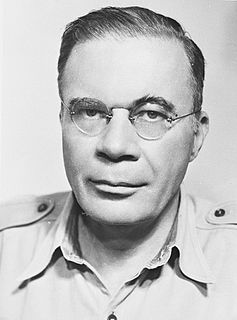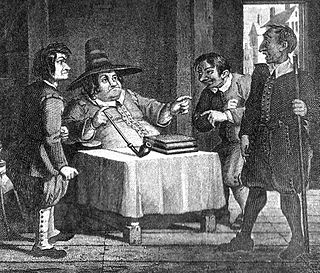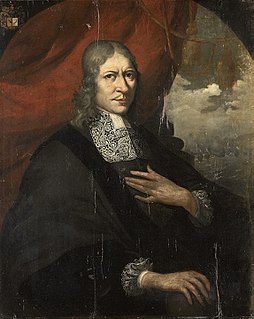Related Research Articles

Hubertus Johannes "Huib" van Mook was a Dutch administrator in the East Indies. During the Indonesian National Revolution, he served as the Acting Governor-General of the Dutch East Indies from 1942 to 1948. Van Mook also had a son named Cornelius van Mook who studied marine engineering at the Massachusetts Institute of Technology. He also wrote about Java - and his work on Kota Gede is a good example of a colonial bureaucrat capable of examining and writing about local folklore.

Abraham van Riebeeck was a merchant with the Dutch East India Company and the Governor-General of the Dutch East Indies from 1709 to 1713.

Wouter van Twiller was an employee of the Dutch West India Company and the Director of New Netherland from 1632 until 1638. He succeeded Peter Minuit, who was recalled by the Dutch West India authorities in Amsterdam for unknown reasons.

Gustaaf Willem, Baron van Imhoff was a Dutch colonial administrator for the Dutch East India Company (VOC). He served as Governor of Ceylon from 1736 to 1740 and as Governor-General of the Dutch East Indies from 1743 until his death in 1750 at Istana Cipanas.

Nicholas van Hoorn was a merchant sailor, privateer and pirate. He was born in the Netherlands and died near Veracruz after being wounded on the Isla de Sacrificios. Nikolaas or Klaas was engaged in the Dutch merchant service from about 1655 until 1659, and then bought a vessel with his savings. With a band of reckless men whom he had enlisted, he became a terror to the commerce of the Dutch Republic and the Spanish Empire. Later he had several ships in his employment and obtained such notoriety that some governments were willing to employ him against their enemies.

Johannes, Count van den Bosch was a Dutch officer and politician. He was Governor-General of the Dutch East Indies (1830–1833), commander of the Royal Netherlands East Indies Army, Minister of Colonies, and Minister of State. He was an officer in the Military William Order.

Rijcklof Volckertsz. van Goens was the Governor of Zeylan and Governor-General of the Dutch East Indies. He was the Governor of Zeylan from 12 May 1660 to 1661, then in 1663 and finally from 19 November 1664 to 1675 during the Dutch period in Ceylon. He was also served as Council Member of India during 1679. Van Goens’ managed to monopolize the cinnamon trade, get hold of the Malabar pepper and drive away the Portuguese from Ceylon and the Coromandel Coast for the VOC.

Dirck van Cloon was Eurasian Governor-General of the Dutch East Indies. He died of malaria at the age of 46.

Abraham Patras was Governor-General of the Dutch East Indies from 11 March 1735 until 3 May 1737. He was born in Grenoble of a refugee French Huguenot family. In 1685, his family fled to the Netherlands.
The Kew Letters were a number of letters, written by stadtholder William V, Prince of Orange between 30 January and 8 February 1795 from the "Dutch House" at Kew Palace, where he temporarily stayed after his trip to England on 18 January 1795. The letters were written in his capacity of Captain-general of the Dutch Republic to the civil and military authorities in the provinces of Zeeland and Friesland, to the officers commanding Dutch naval vessels in British harbours and to Dutch colonial governors. It urged them to continue resistance in cooperation with Great Britain against the armed forces of the French Republic that had invaded the Dutch Republic and forced him to flee to England. In particular the letters to the colonial governors played an important role, because they ordered them to surrender those colonies to the British "for safekeeping".

Christoffel van Swoll was Governor-General of the Dutch East Indies from 17 November 1713 until his death.

Jeremias van Riemsdijk was a Dutch colonial administrator who served as Governor-General of the Dutch East Indies from 1775 to 1777.

Reynier de Klerck (1710–1780) was Governor-General of the Dutch East Indies from 1778 until 1780.

Pieter Gerardus van Overstraten was Governor-General of the Dutch East Indies from 1796 until 1801. He was the last Governor-General of the Dutch East India Company, which was dissolved, bankrupt in 1799, but he remained in post as the Dutch state took over ruling its territories in the Indies. In that sense, he was also the first state appointed Governor-General of the Dutch East Indies.

Cornelis van der Lijn was Governor-General of the Dutch East Indies from 1646 until 1650.

Antoon Arnold Marie "Teun" Struycken was a Dutch politician of the defunct Catholic People's Party (KVP) now merged into the Christian Democratic Appeal (CDA).

Otto van Rees was a Dutch liberal politician and colonial governor of the Dutch East Indies.

The Governor-General of the Dutch East Indies represented Dutch rule in the Dutch East Indies between 1610 and Dutch recognition of the independence of Indonesia in 1949.
The Dutch–Ahanta War was a conflict between the Netherlands and the Ahanta between 1837 and 1839. Beginning with a mere economic dispute between the Ahanta and the Dutch, who were based at the Dutch Gold Coast, the conflict ended with the hanging of Ahanta king Badu Bonsu II and the reorganization of the Ahanta state, establishing a Dutch protectorate over the Ahanta.
Lubbert Jan baron van Eck was the 31st Governor of Ceylon during the Dutch period in Ceylon.
References
- ↑ Cahoon, Ben. "Dutch Governors". Worldstatesmen. Retrieved 1 March 2013.
| Government offices | ||
|---|---|---|
| Preceded by Joan Maetsuycker | Governor of Zeylan 1650-1653 | Succeeded by Adriaan van der Meyden |